OPINION | Wild Wild Country, or how blending religion with power went haywire
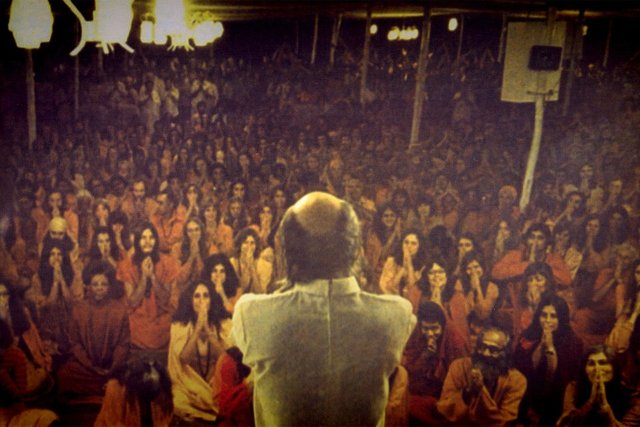
Every single story that begins with a bald man in white robes speaking to a crowd ends badly… Just saying | Source: Vanity Fair

In 1981, an amazing story began to unfold near the town of Antelope, located in Wasco County, northern Oregon. Before the perplexed gaze of the forty-two local residents, a violet tide of outsiders - both Americans and foreigners - began to arrive in town in order to receive a mysterious figure. These intruders called themselves sannyasins or Rajneeshees and, as contemporary accounts say, they were waiting for their leader.
Nowadays, we know the leader of this spiritual movement, originally born as Chandra Mohan Jain, as Osho. However, at that time, his name was Rajneesh. Bhagwan Shree Rajneesh. Having started a successful spiritual community, or ashram, in Pune, India, Rajneesh decided to immigrate to the United States with a crystal-clear idea in his mind.
The Indian guru wanted to create a commune for his disciples on U.S. soil, enjoying and taking advantage of the stability and democracy provided by the American dream in the meantime.
Although many comments and articles speak of Rajneesh running from political tensions provoked between his movement and the Janata Party, followers of the Prime Minister of India, Morarji Desai. After a previous reconnaissance led by his secretary and confident at the time, Ma Anand Sheela, Rajneesh finally arrived at the United States in August 1981.
What would follow would be one of the darkest and most incredible chapters in contemporary American history. A conflict that would not only call into question the validity of Rajneesh's philosophical movement, but would also attract the gaze of both an increasingly concerned U.S. government about illegal migratory movements on its territory, and a society in which conservative tendencies and the omnipresent bond between religion and power generally end in frightening, backward results.
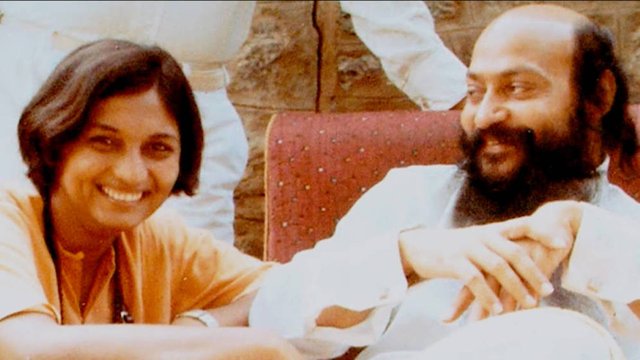
Back then, these two were the leaders of a respected, loved spiritual movement. It feels almost unbelievable that they would be convicted criminals barely years afterward | Source: El Confidencial
Under the gaze of both locals and foreigners, at the Big Muddy Ranch on the outskirts of Antelope, the sannyasins began to build, with an immense investment in both human effort and money, an oasis in the arid plains of Oregon. This utopian community, called Rajneeshpuram, would be the center of an enormous controversy between government and worship, between citizens and followers; being the basis of a culture and belief that had little or nothing to do with traditional American ideals, these sparks did not take long to ignite and create a hell-on-Earth that lasted for about four years.
Even after dubious legal manoeuvres by the Rajneeshees to make their conviction more, say, palatable - during which they even won a popular referendum questioning the validity of their stay in Oregon - more confrontational and even violent actions took over the cult in the belief that the American refusal to share their territory with them was motivated by a government-led conspiracy. With the absolute silence of their guru and the apparent total confidence in the judgment of a Ma Anand Sheela who, more than a secretary to the savant, seemed to set herself up as a dictator on her own, the Rajneeshees were involved in attacks of all kinds against the state community.
The rising tensions even led to assassination attempts.
Organized by Sheela's strategic vision, the Rajneeshees went from being a movement preoccupied with such new age issues as meditation, free love and, yes, sex – quite a lot of it, according to witnesses - to more militant, radical measures, knowing that they would have to protect their Shangri-La with bullets and even their own lives if necessary.
That revolutionary dream, of course, would be short-lived.
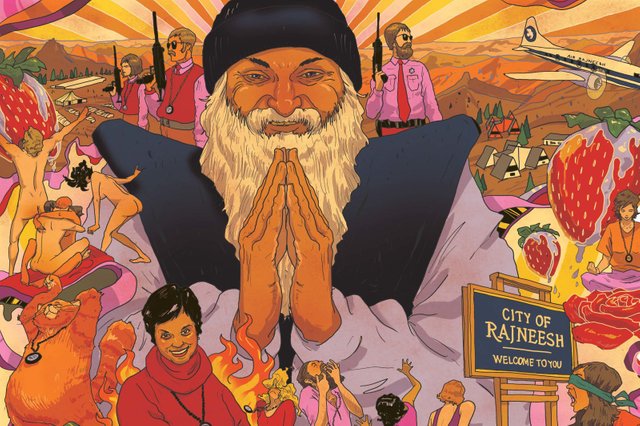
The outlandish, amazing story that Wild Wild Country tells us could have only happened on the 80s… or not? | Source: Portland Monthly
After a breakup between the guru and his former favorite, Ma Anand Sheela fled Rajnishpuram with a small group of followers. What had hitherto been a situation under control turned into a veritable battle of accusations, rumors and disagreements that shocked American public opinion even more than it had already done.
There, amongst chaos, law enforcement saw its opportunity.
Having amassed enough evidence of various Rajneesh community mismanagement accusations and their spiritual leader’s lack of coherence, the federal government - in the guise of Oregon federal prosecutor Dave Frohnmeyer and his young assistant, Robert Weaver - decided to put an end to the situation before it got out of hand. After an investigation conducted directly on Rajneesh soil, it was determined that this cult had incurred a series of immigration and administrative illegalities long before Sheela's peculiar leadership vision became a reality.
The result?
Bhagwan Shree Rajneesh and, barely weeks later, Ma Anand Sheela were put behind bars.
Rajneesh, after a controversial agreement with the authorities, was able to return to India.
Sheela was not so lucky.
Today, this story is only a vague memory for many, except for those who lived this dizzying time in their own flesh... and for the Way brothers.
Known for their love of documentaries, Chapman and Maclain Way are a creative duo from Ventura County, California who came to the public limelight after their well-received Netflix documentary, The Battered Bastards of Baseball (2014). This series told the nigh-unbelievable story of the Portland Mavericks, an independent baseball team founded by none other than Kurt Russell's father, former minor league player and actor Bing Russell. Showing the unusual and amusing relationship between the entertainment industry and a passion for baseball - truth be told, this team served more to catapult actors' careers than to leave an indelible mark on the sport - the series had a good critical and audience reception in the United States.
However, this would not be the only story the Way brothers would dig in Oregon.
After four years of interviews, research and meetings with most of the still-living protagonists of the Rajneesh invasion, the duo, again in association with Netflix, premiered Wild Wild Country in March 2018. The documentary series in question became, overnight, a great success with critics and audiences around the world.
Considering the story they tell - and, more importantly, the way they tell it - the Way brothers have fully earned their recognition.
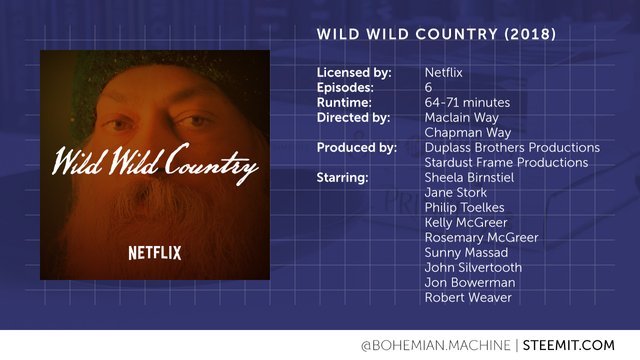

Wild Wild Country begins with a very wise choice; introducing us to a carefully curated selection of Wasco County citizens who still remember those events, just as if they happened yesterday. Although the cast of interviewees in this documentary is huge, the Way brothers know how to organize it into various strata, both for its appearance and relevance and for the sides they eventually picked. These people, distributed by origin and affiliation, are:
Citizens of Oregon
- John Silvertooth, current mayor of Antelope and one of Rajneeshpuram’s elected councilmen after its establishment as an officially recognized city by Oregon’s federal government.
- Jon Bowerman, Oregonian rancher, son of Bill Bowerman - yes, THE Bill Bowerman who founded the legendary sportswear company Nike - and one of the most fervorous opponents of Rajneeshpuram’s founding.
- Kelly and Rosemary McGreer, a couple of Oregon ranchers who lived in the vicinities of Big Muddy Ranch and eventually signed the eviction proposal led by the Bowerman family.
Rajneeshees
- Sheela Birnstiel, a.K.a. Ma Anand Sheela, Bhagwan Shree Rajneesh's privileged and powerful secretary during the creation of Rajneeshpuram and the cult's confrontation with both the federal government and citizens of Oregon.
- Jane Stork, a.K.a. Ma Shanti B, a fervent follower of Rajneesh who gradually positioned herself as one of the right hands of Ma Anand Sheela.
- Philip Toelkes, a.K.a. Swami Prem Niren, main legal advisor of the Rajneeshpuram commune and a trusted man both from Rajneesh and Sheela’s part.
- Sunny Massad, a.K.a. Ma Prem Sunshine, Rajneeshpuram's chief spokesperson during Sheela's ruthless rule.
- John Joseph Shelfer, a.K.a. Swami Prem Jayananda, Sheela's second husband and current president of the Rajneesh Foundation International
Federal Government and History of Oregon experts
- William Gary, Assistant U.S. Attorney Dave Frohnmayer during Wasco County's investigation into the Rajneesh community.
- Robert "Bob" Weaver, assistant attorney to federal prosecutor Dave Frohnmayer during the investigation and current legal counselor to various private firms
- Mark Greenfield, legal advisor to the 1000 Friends of Oregon group led by Bill Bowerman and expert in the formal circumstances of the Rajneeshpuram case.
- Les Saitz, a reporter for the regional newspaper The Oregonian and one of the most informed people alive about the Rajneeshpuram case
In addition, the Way brothers make use of countless archive pieces that show us the standing of several other people in this story who, in spite of their death or refusal to be interviewed or located, formed a fundamental part of it nevertheless:
- Bhagwan Shree Rajneesh, later known as Osho, spiritual leader and founder of the Rajneesh movement (deceased 1990)
- David Berry Knapp, a.K.a. Krishna Deva, first and only mayor of Rajneeshpuram and fervent spokesman for the Rajneesh movement who would fall into disgrace shortly after the discovery of his involvement, along with Sheela, in several attacks against American citizens (he refused to talk to the Way brothers from the first day of production).
- Margaret Hill, mayor of Antelope before the Rajneesh takeover and fierce opponent of Sheela's ambitions (deceased in 2016)
- David B. "Dave" Frohnmeyer, Oregon politician, administrator and federal prosecutor during the Rajneeshpuram case (deceased in 2015)
- Charles Turner, Wasco County prosecuting attorney who played a fundamental part in the creation of the Rajneeshpuram case and was the target of a Rajneesh death squad (deceased in 2018).
That the Way brothers managed to gather the testimony of all these people and their views during just six episodes is commendable. Through both their personal stories and their involvement in these harsh and surprising four years of American history, it is this group of people who spin - thanks to an impartial direction by the creative duo behind this series - a narrative that speaks of a United States that seems more current than ever after the internal tensions raised by the Trump era. A nation that continues to debate between liberalism and respect for tradition, that seems capable only of accepting new ideas as long as they serve their purposes and do not go against the American way that much.
A reality that, of course, does not even remotely make the Rajneeshes innocent.
Because, if Wild Wild Country is proof of anything, it is that the road to hell is paved with good intentions.
By this picture alone, you would not be able to judge that this sweet old lady was Rajneeshpuram’s fierce dictator and relentless protector during the 80s | Source: Vulture
For some strange reason, spirituality has no match by anything when it comes to showing the true nature of the human condition. Our need to believe, to give a philosophical and mystical background – preferably blessed by a deity or superior entity - to us and our actions, ends up turning said facts into the subjective. When a singular person, with innovative and reactionary visions to a time that may seem singularly oppressive or difficult, raises his voice, he will undoubtedly attract followers. The fate of that group will depend not only on the validity of his point of view but also on his/her many weaknesses as a leader.
The Rajneeshes, if what we see in Wild Wild Country is to be trusted, did not pass this test.
From the very beginning of this documentary, it is clear that whatever Rajneesh wanted to create in the prairies of Oregon - the series, unfortunately, is not as specific and sharp as it could have been in crumbling the character of his spirituality - his apparent utopia quickly succumbed to deeply human needs and issues. Tribalism, craving for power, ambition and lack of restraint on the part of the conflicting parties only created deep cracks in the project. Cracks that the omnipresent and adored guru of the Rajneeshees either did not know or would not control.
And this, perhaps, is one of the few aspects in which Wild Wild Wild Country could have done better; perhaps because of a conflict of interest, the Way brothers did not allow themselves to go any further in documenting the life of a man who was not as holy or perfect as his followers would like us to believe. Visibly fond of the good life – on various occasions during the documentary, there is evidence of his particular taste for Rolls Royce and Rolex wristwatches - and not very humble in the actual carrying out his plans, the Way brothers could have done a lot more to reveal the truth about this controversial and dark figure.
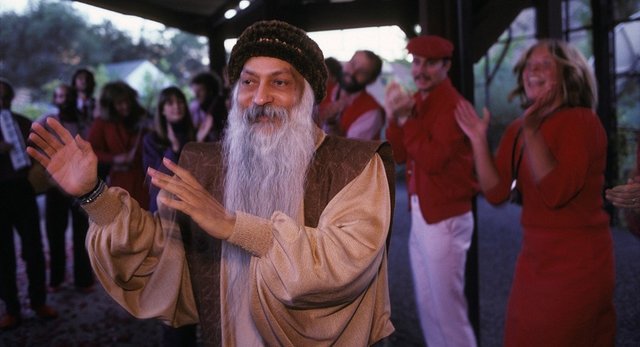
A regrettable thing about Wild Wild Country – perhaps in the interest of not affecting Rajneesh interviewees – is a perceived lack of interest in telling us who his controversial leader really was | Source: Los Inrockuptibles
A lot has been said about Ma Anand Sheela, especially thanks to this series’ success. Once a ruthless, horrendous figure to the eyes of the average American, now a resident of Switzerland and widow of a third marriage, she is perhaps one of the documentary’s two central figures. At every minute of Wild Wild Country, we watch her, undaunted, as a woman who, while she seems genuinely repentant of how the Rajneesh movement, in her eyes, degenerated and weakened, does not share such reluctance towards her actions.
The role of the anti-villain is an extremely fascinating one among those recognizable in any narrative, especially in modern times. The anti-hero already showed us a long time ago that yes, many times, even if you believe that you are doing evil, selfish things, you actually end up being the catalyst for good, sorely needed actions.
What happens, though, when the opposite takes place? When, in the belief of doing great things, you end up doing vile atrocities?
Essentially, you get a Sheela.
Some might think that Wild Wild Country attempts to sell a story of redemption about this controversial figure of the Rajneesh movement; near the series’ end, it is understandable to think that. After knowing barely a subset of the many horrendous attacks, abuses and humiliations she was able to order - another aspect in which, perhaps, this series would have needed one or two additional episodes - we see that Sheela apparently, after twenty-nine months in prison and a self-imposed exile in Switzerland, has redeemed herself somehow.
Nevertheless, the truth is that Sheela is anything but this story's Ozymandias, and the big question that will remain in the air is… Did she really serve a fair sentence for everything she did? Is she truly sorry about almost killing dozens of people, including politicians and local government figures, in search of a vain, unfounded ideal?
In this regard, the series can and will only invite us to judge that fact ourselves.
Swami Pree Niren’s naiveté and his strong sense of loyalty to Osho is a sample of the true, devastating reach of Rajneesh teachings, for good or for worse | Source: Vulture
The other central figure of Wild Wild Country, without a doubt, is Swami Prem Niren. Rajneesh's self-sacrificing lawyer and legal adviser, of all the Rajneeshees, is not only the one most affected by the whole story but also the one who seems to have frozen in time. Convinced that Rajneeshpuram fell for an open, vicious conspiracy between the federal government and a group of people who were reluctant to share the ideals of their leader, Niren is something like Osho’s perfect follower. One cannot but respect his loyalty and lament his naiveté in equal parts for, akin to Ma Shanti B’s sad story of redemption, his part in this also reeks of personal tragedy.
Another devastating conclusion that Wild Wild Country presents us is that luckily or terrifyingly depending on how we see it, American idiosyncrasy has changed very little in the following years. While it is true that the American dream is, so far, the closest thing to that elusive ideal of freedom that we humans both seek and are terrified of actually having, it is surprising to see the enormous differences that exist between urban America and rural America with such clarity and how, even so, both agree on one thing:
Their deep intolerance of anything other than themselves.
On the other part, Wild Wild Country’s picture about American society is unrelenting, both on its victims and its aggresors | Source: Vulture
Is this aspect of the series a veiled apology to the Rajneesh movement? If so, who were the real villains in this story? The truth is, after six very tense chapters, Wild Wild Country ends up leaving us with more questions than answers. By not directly advocating for any of those involved, the Way brothers have painted in their series a hard-to-digest picture of virtually everything that involves human nature. Inviting us, as viewers, to continue research on our part to discover what might be a disturbing truth:
When we fervently believe in anything, we can all be villains.
Thank you for reading my post!
I try to answer every comment, so feel free to leave yours on the comment section below 👇
100% original content by yours truly,
